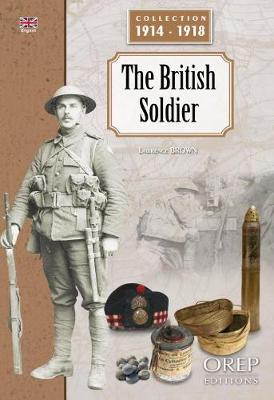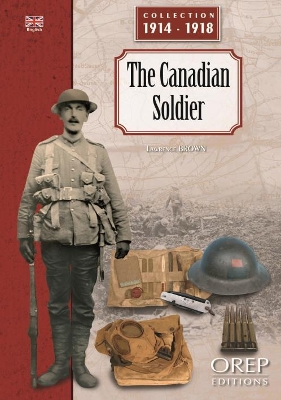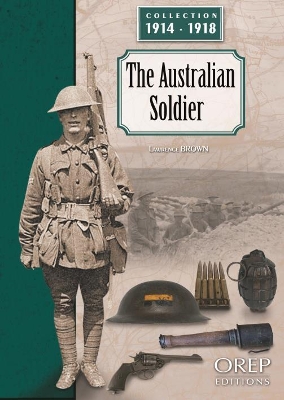Collection 1914-1918
6 total works
Almost a century has passed since the signing of the armistice on 11 November 1918. Of all the soldiers who went through that hell on earth, photographs, letters, stories and old uniforms kept in attics are all that is left. Thanks to a collection of more than ten thousand documents, the author allows us to follow these young men with previously unseen photographs. All these faces, sometimes smiling, sometimes serious, have a story to tell. Many collectors have also allowed us access to their most precious objects, the fruit of their relentless research that helps save these objects that went through four terrible years of oblivion and destruction. Finally, being in the era of Internet, many links allow you to retrace the history of your ancestors and their regiments.
During World War One, the well-known blue and red uniform of the French army has taken different shapes, but it is not the only thing that has changed: rifles, grenades, pistols, bayonets, head-wears, etc. have seen different forms or, for some of them, were introduced during the war. Those changes are shown in this short book about the French soldier's equipment and his commitment within the French army.
During World War One, the well-known blue and red uniform of the French army has taken different shapes, but it is not the only thing that has changed: rifles, grenades, pistols, bayonets, head-wears, etc. have seen different forms or, for some of them, were introduced during the war. Those changes are shown in this short book about the French soldier's equipment and his commitment within the French army.
Almost a century has passed since the signing of the armistice on 11 November 1918. Of all the soldiers who went through that hell on earth, photographs, letters, stories and old uniforms kept in attics are all that is left. Thanks to a collection of more than ten thousand documents, the author allows us to follow these young men with previously unseen photographs. All these faces, sometimes smiling, sometimes serious, have a story to tell. Many collectors have also allowed us access to their most precious objects, the fruit of their relentless research that helps save these objects that went through four terrible years of oblivion and destruction. Finally, being in the era of Internet, many links allow you to retrace the history of your ancestors and their regiments.
When Germany invaded Belgium in 1914, Britain mobilised its army in addition to its navy, and declared war on Germany. The British Army that disembarked in France in August 1914 was a small but highly efficient force. Led by Sir John French, the army was strong from the lessons it had learnt from colonial wars, but couldn't avoid the settlement of the front line leading to trench warfare. The subject of this short book is a non-exhaustive study of the British soldier's equipment and his commitment within the British Expeditionary Force.
When Germany invaded Belgium in 1914, Britain mobilised its army in addition to its navy, and declared war on Germany. The British Army that disembarked in France in August 1914 was a small but highly efficient force. Led by Sir John French, the army was strong from the lessons it had learnt from colonial wars, but couldn't avoid the settlement of the front line leading to trench warfare. The subject of this short book is a non-exhaustive study of the British soldier's equipment and his commitment within the British Expeditionary Force.
Almost a century has passed since the signing of the armistice on 11 November 1918. Of all the soldiers who went through that hell on earth, photographs, letters, stories and old uniforms kept in attics are all that is left. Thanks to a collection of more than ten thousand documents, the author allows us to follow these young men with previously unseen photographs. All these faces, sometimes smiling, sometimes serious, have a story to tell. Many collectors have also allowed us access to their most precious objects, the fruit of their relentless research that helps save these objects that went through four terrible years of oblivion and destruction. Finally, being in the era of Internet, many links allow you to retrace the history of your ancestors and their regiments.
The subject of this short book is a non-exhaustive study of the German soldier's equipment and his commitment within the German army based on the documents, weapons, and uniforms found.
The subject of this short book is a non-exhaustive study of the German soldier's equipment and his commitment within the German army based on the documents, weapons, and uniforms found.
Almost a century has passed since the signing of the armistice on 11 November 1918. Of all the soldiers who went through that hell on earth, photographs, letters, stories and old uniforms kept in attics are all that is left. Thanks to a collection of more than ten thousand documents, the author allows us to follow these young men with previously unseen photographs. All these faces, sometimes smiling, sometimes serious, have a story to tell. Many collectors have also allowed us access to their most precious objects, the fruit of their relentless research that helps save these objects that went through four terrible years of oblivion and destruction. Finally, being in the era of Internet, many links allow you to retrace the history of your ancestors and their regiments.
The Canadian Expeditionary Force arrived with its infantry division in France in February 1915. The Canadians underwent the first poison gas attack two months later. In 1918, they had such a reputation that they were used as shock troops and took part in all the battles of the year. The subject of this short book is a non-exhaustive study of the Canadian soldier’s equipment and his commitment within the Canadian Expeditionary Forces in France in 1915-18.
The Canadian Expeditionary Force arrived with its infantry division in France in February 1915. The Canadians underwent the first poison gas attack two months later. In 1918, they had such a reputation that they were used as shock troops and took part in all the battles of the year. The subject of this short book is a non-exhaustive study of the Canadian soldier’s equipment and his commitment within the Canadian Expeditionary Forces in France in 1915-18.
Almost a century has passed since the signing of the armistice on 11 November 1918. Of all the soldiers who went through that hell on earth, photographs, letters, stories and old uniforms kept in attics are all that is left. Thanks to a collection of more than ten thousand documents, the author allows us to follow these young men with previously unseen photographs. All these faces, sometimes smiling, sometimes serious, have a story to tell. Many collectors have also allowed us access to their most precious objects, the fruit of their relentless research that helps save these objects that went through four terrible years of oblivion and destruction. Finally, being in the era of Internet, many links allow you to retrace the history of your ancestors and their regiments.
Following their baptism of fire at Gallipoli in 1915, the Australians arrived on the Western Front in spring 1916. A few months later came the Somme with 24,000 casualties and the tragic events of Fromelles. Then, these tough men, who had travelled so far, continued fighting in France in 1917 and 1918. Since then, the bond of friendship between France and Australia is still going strong.
Following their baptism of fire at Gallipoli in 1915, the Australians arrived on the Western Front in spring 1916. A few months later came the Somme with 24,000 casualties and the tragic events of Fromelles. Then, these tough men, who had travelled so far, continued fighting in France in 1917 and 1918. Since then, the bond of friendship between France and Australia is still going strong.
Almost a century has passed since the signing of the armistice on 11 November 1918. Of all the soldiers who went through that hell on earth, photographs, letters, stories and old uniforms kept in attics are all that is left. Thanks to a collection of more than ten thousand documents, the author allows us to follow these young men with previously unseen photographs. All these faces, sometimes smiling, sometimes serious, have a story to tell. Many collectors have also allowed us access to their most precious objects, the fruit of their relentless research that helps save these objects that went through four terrible years of oblivion and destruction. Finally, being in the era of Internet, many links allow you to retrace the history of your ancestors and their regiments.
In 1917, the American army joined the war, boosting the morale of existing troops and offering a momentum to the offensive. Initially a small and poorly equipped force of 135,000 men, the American army was rapidly transformed into an expeditionary force which, by the end of the conflict, comprised 2 million men. The subject of this short book is a non-exhaustive study of the American soldier's equipment and his commitment within the American Expeditionary Forces in France in 1917-18.
In 1917, the American army joined the war, boosting the morale of existing troops and offering a momentum to the offensive. Initially a small and poorly equipped force of 135,000 men, the American army was rapidly transformed into an expeditionary force which, by the end of the conflict, comprised 2 million men. The subject of this short book is a non-exhaustive study of the American soldier's equipment and his commitment within the American Expeditionary Forces in France in 1917-18.





